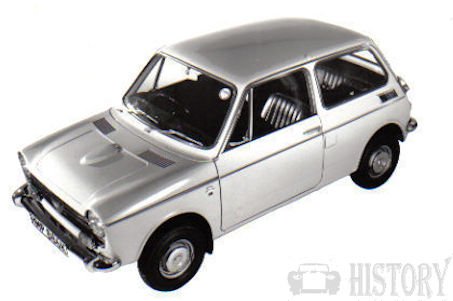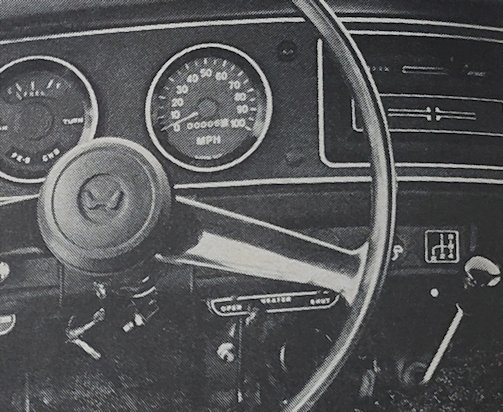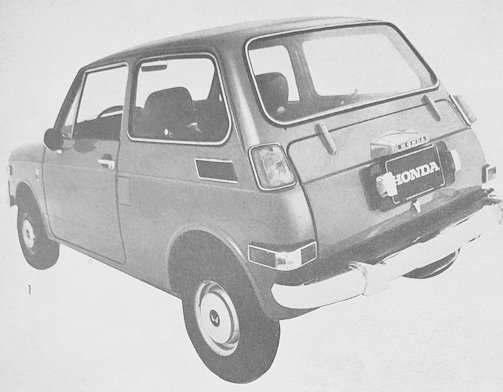Honda N600
 |
|
|
country of manufacture |
Japan |
|
Sales period |
1967 to 1973 |
|
Class |
Motor Car |
|
body type |
2 -door fastback sedan |
|
Drive system |
FF |
|
engine |
Forced air-cooled 4-stroke 2-cylinder SOHC 598cc |
|
Maximum output |
43PS/6,600rpm |
|
Maximum torque |
5.2kgf m/5,000rpm |
|
Wheelbase |
78.75 in, 2,000 mm |
|
full length |
122.05 in, 3,100 mm |
|
Width |
51 in, 1,295 mm |
|
Height |
52.36 in, 1,330 mm |
|
vehicle weight |
1,213 1b, 550 kg |
The Honda N600 is a small car of the car manufacturer Honda.
History
JAPAN'S equivalent of the Mini has a tiny twin-cylinder engine transversely mounted and driving the front wheels. It is air-cooled, has an overhead camshaft, and runs happily up to
over 8000 r.p.m. if you don't mind the noise. You can make music with the four-speed box or take it easy with little loss of performance using the Hondamatic drive with torque converter and three speed gears.
Announced at the 13th Tokyo Motor Show in 1966. Sales started in March 1967. The N360 sold as the N400 / N600 for overseas and the N600E sold for Japan. It adopted a front-wheel drive (FF) system to secure a spacious cabin space, and was equipped with a high-output engine sparked the "horsepower competition" in the Kei car industry at the time. The combination of high performance and low price made it the best-selling model at the time.
By May, 1970, the Honda 600, after several introductions, finally became a reality on the American market. True to the name of its manufacturer, the 600 is scarcely more than a motorcycle. But for those who cannot or will not ride a bike, the 600 will give nearly as good economy and ease of maintenance.
The engine is a 600cc motorcycle-type, giving 36 bhp at 6000 rpm, and 75 mph is possible if you really want to wind it out. An all-synchro 4-speed transmission is fitted, and engine and transmission oil are common. Obviously,the 600 is a front-wheel drive design. All of these features add up to economy, simplicity and ease in city driving.
The body and interior, though Spartan, are solidly constructed and comply with U.S. safety standards one of the reasons the Honda was so slow in coming. There really isn't any room in the back except for someone used to solitary confinement, but the space is very adequate for a driver and passenger. Rack and pinion steering is quick and responsive and so are the brakes (discs front, drums rear), but you really have to keep the engine well up inrevs to keep up with the bigger cars at stops.
Overall ride is good, but like most short-wheelbase vehicles it becomes thumpy over rough areas. Like many front-wheel drives, large or small, there is understeer and a nose-dive effect if the throttle is released when going into a corner. The word which best describes the 600 is agility, not performance.

The 2-door, 2-box shape was designed to increase the cabin space by arranging small-diameter tires at the four corners. It had an extremely spacious cabin for a mini passenger car of the time, and its design concept and drive system were strongly influenced by the British made Mini. It also has a trunk lid in common with the mini, but this model adopts a trunk through structure that omits the rear bulkhead and tray but Soichiro Honda didn't like the original rear design, so he ordered the clay model, which had already been made for production, to be scraped. The initial speedometer was a simple design reminiscent of a tester 's indicator, and the shift lever was a kind of " instrument panel shift " that protruded from the bottom of the dashboard. The steering shaft protrudes from the centre of the floor, and was designed to accommodate both left- and right-hand drive versions.
suspension: front, independent, MacPherson strut, coil springs, rear, beam axle, semi-elliptic springs with telescopic dampers; jacking system: scissor jack, rear axle and front sub-frame jacking points. Automatic transmission with torque converter; 3- speed gearbox, manual override, ratios, first 2.421, second 1.357, third 0.838, reverse 3.857, overall 13.07, 7.34, 4.53, reverse 20.84; maximum torque multiplication 2.4. 3.5 in. x 10 in. pressed steel wheel rims, 5.20-10 tyres.
Body: pressed steel monocoque; 2 forward-hinged doors with winding windows and recessed controls; opening rear windows; fresh air type heater; manual windscreen washers;
electric windscreen wipers; interior mirror; underseal; automatic reversing lamps; interior light; padded facia, steering wheel boss and rear of front seats.
de luxe fitted carpet; cigarette lighter; overriders; passenger sun visor; improved door trim; improved sound insulation. Metallic finish available.
It adopted front - wheel drive with a transverse engine mounted at the front. The engine is a 4-stroke forced air- cooled inline 2-cylinder chain drive SOHC, developed based on the air-cooled parallel 2-cylinder DOHC engine installed in the Honda motorbike CB450. For this reason, the timing chain is placed in the middle of the camshaft and crankshaft, similar to a two-cylinder motorcycle, rather than at one end of the cylinder block like in a normal car engine. This engine has a displacement of 354 cc and a maximum output of 31 PS at 8,500 rpm from an inner diameter x stroke of 62.5 x 57.8 (mm). Light cars made by other manufacturers at this time were mainly 2-stroke engines, and their maximum output was generally in the low 20PS range, so it was a remarkably high output. This is the result of applying the method of earning power by allowing high revs, which Honda Motor Co., Ltd. is good at with motorcycles. The nominal maximum speed of 115 km/h was also the highest level among mini passenger cars at the time. Due to the structure of the engine, noise and vibration are somewhat intense, but priority is given to ensuring performance and simplifying the structure, and anti-vibration and soundproofing measures are kept to a simple level.
PERFORMANCE
- Engine capacity: 36.53 cu in, 598.70 cu cm
- Fuel consumption 47 m/imp gal, 39.2 m/US gal, 6 1 x 100 km
- Max speed: 80.8 mph, 130 km/h
- max power (DIN): 42 hp at 6,600 rpm
- max torque (DIN) 40 1b ft
- max engine rpm: 7,500
- specific power: 70.1 hp/l
- power-weight ratio: 28.9 lb/hp, 13.1 kg/hp
- acceleration: standing 1/4 mile 19.7 sec
- max speeds: 27.7 mph, 44.5 km/h in 1st gear; 44.7 mph, 72 km/h in 2nd gear; 69.9 mph, 112.5 km/h in 3rd gear; 80.8 mph, 130 km/h in 4th gear
The 4-speed manual transmission was close to the structure of a motorcycle in the initial model, and was equipped with a constant mesh dog mission that was arranged in series with the engine. The front suspension uses independent coil springs and struts, while the rear uses semi-elliptical leaf spring axle suspensions. The cabin heating uses the waste heat of the air-cooled engine, so the smell of gasoline and engine oil enters the car, which is disadvantageous in terms of temperature control, but simplicity was given priority.
There was only one grade when it was first released, and the price was set at 313,000 yen at Saitama Factory Sayama Factory (now Saitama Factory Sayama Completed Vehicle Factory) and 315,000 yen at Tokyo and Kanagawa stores, which was set by other companies in the same class at 350,000 yen. It was considered to be a significantly cheaper level than the yen ~ 450,000 yen. With its high performance and low price, it became popular with the general public and became a hit. In June of the same year, a light van type "LN360" was added as a sister car. In April 1968, the "N360 AT" equipped with Honda's first automatic transmission was also released. This product was developed in-house and was called " Hondamatic." Unlike the semi-automatic "Hondamatic" that was later installed in the Civic, etc., this "Hondamatic" was a full-fledged 3-speed fully automatic, and the select lever was installed on the handlebar column. It was a 7-position type of "PRND-3-2-1" (each position of 3, 2, 1 is fixed to each gear). The maximum speed reaches 110km/h, which is almost comparable to a 4-speed MT car.
In July 1968, the "N360 sunroof" with a canvas top was added. In September 1968, the T, TS, TM, and TG grades, which were equipped with twin carburettors and generated 36ps/9,000rpm, were added (T stands for Twin). Maximum speed 120km/h.
Honda had already exported the "S series" overseas, but when the "N360" was developed, the "N400”, which expanded the displacement to 400cc based on this, was equipped with a 600cc engine and a maximum speed of 130km/ H "N600" was manufactured and exported to the United States and Europe. In Europe, due to the selection of manufacturers due to intensifying competition and the shift to higher-end production models, the number of inexpensive small-displacement minicars, which is the smallest class, has gradually decreased. Because it is an output vehicle, it has achieved a certain level of sales performance, receiving support from users who have restrictions on income and license system, mainly among young people. Also, in West Germany at the time, cars with a capacity of 250cc or less had preferential taxation and licensing systems similar to those of Japanese Kei cars, so there were some local users who used a bore-down kit to upgrade to 250cc.
The 600cc model was also marketed in Japan from June 1968 as the "N600E", but contrary to its success overseas, it was treated as a regular car under tax law despite having the same level of comfort as a light car. Sales were sluggish from the beginning, and sales ended with about 1,500 units for only half a year. This is the shortest life for a mass-produced passenger car from a major manufacturer. Mechanically, there were some parts that were the same as those for export, but the interior and mechanical details were completely different. For the company, it is the first vehicle to be registered as a four-seat passenger car for the Japanese domestic market.
The model was changed in January 1969. In this model, commonly known as the N II, the exterior design was changed only slightly, but the interior was covered with panels for most of the dashboard, creating a car-like mood.
In January 1970, it evolved into the "N III" due to another model change. In this model change, the name was officially changed to "N III 360", and the exterior was also greatly improved. The characteristic 4-speed MT has been changed from a dog mission to a general full sync type. In addition, "N III 360 Town" was added in September of the same year, with a high-speed, high-output engine that was a symbol. Town's engine, which emphasizes low-speed performance, is tuned to 27ps/7,000rpm (torque remains unchanged). The "N360" has sold 250,000 units in less than two years since its release, and the total production volume has reached 650,000 units.
After 1969, influenced by the "defective car problem" that had become a social problem in the United States led by Ralph Nader, a movement to condemn defective cars occurred in Japan as well. One of the groups that showed this kind of movement was the Japan Automobile User Union, which pointed out that the best-selling car of the time, the N360, had serious defects in terms of steering stability. In 1970, the bereaved family of the driver who died while driving the N360 filed a lawsuit against Soichiro Honda with the Tokyo District Public Prosecutors Office for unintentional and intentional murder. On November 20, 1970, the National Police Agency picked up seven cases that could not be determined to be driving errors, and sent materials to the Ministry of Transport to request a technical judgment. In seven cases, when three or four people were boarding, the vehicle rolled over or left the lane due to meandering when accelerating or approaching a downhill (note: the speed at the time of the accident was not specified)., There were also accidents where factors other than defects could be seen, such as cases where the tires were shaved). In response, the Ministry of Transport reiterated the claim that "according to the materials submitted by Honda Motor Co., Ltd., there seems to be no defects."

Technical
-
Honda N600 Technical details and specifications (1967-1973)
ENGINE
Engine location: front, 4 stroke, transverse
cylinders: 2, in line
bore and stroke: 2.91 x 2.74 in, 74 x 69.6 mm
engine capacity: 36.53 cu in, 598.70 cu cm
compression ratio:8.5:1
cylinder block: light alloy
cylinder head: light alloy
crankshaft bearings: 4, on roller bearings
valves: 2 per cylinder, overhead, rockers
camshafts: 1, overhead
lubrication: rotary pump,full fiow fitter
carburation: 1 Keihin-Seiki horizontal carburettor
fuel feed: electric pump
cooling system: air-cooled,TRANSMISSION
driving wheels: front
clutch: single dry plate
gearbox: mechanical; gears: 4 + reversesynchromesh gears: all
gearbox ratios: I 2.529,II 1.565, III 1, IV 0.714, rev 2.440
gear lever: central
final drive: helical spur gears
axle ratio: 3.360.CHASSIS
integral,front auxiliary frame
front suspension: independent, byMcPherson, coil springs/telescopic damper struts, lower wishbones
rear suspension: rigid axle, semi-elliptic leafsprings, telescopic dampers.STEERING
rack-and-pinion
turns of steering wheel lock to lock: 3.10.
turning circle (between walls): 31 ft, 9.4 mBRAKES
drum (diameter 7.10 in, 180 mm)
area rubbed by linings: front 37.67sq in, 243 sq cm, rear 37.67 sq in, 243 sq cm
total 75.34 sq in, 486 sq cm.ELECTRICAL EQUIPMENT
voltage: 12 V
battery: 45 Ah
generator type: alternator, 300 W
ignition distributor: HitachiDIMENSIONS AND WEIGHT
wheel base: 78.75 in, 2,000 mm
front track: 45.28in, 1,150 mm
rear track: 43.50 in, 1,105 mm
overall length: 122.05 in, 3,100 mm
overall width: 51 in, 1,295 mm
overall height: 52.36 in, 1,330 mm
ground clearance:6.30 in, 160 mm
dry weight: 1,213 1b, 550 kg
distribution of weight: 67% front axle,33% rear axleOPTIONAL ACCESSORIES
Hondamatic 3F1R automatic gearbox, hydraulic torque convertor and 3-speed constant mesh gears.© Motor car History
Service
-
Honda N600 Service Guide (1967-1973)
width of rims: 3.5"
tyres:5.20 x 10
fuel tank capacity: 6 imp gal, 7.1 US gal
carrying capacity: 772 1b, 350 kg
fuel: 88 oct petrol
engine sump, gearbox final drive oil: 5.30 imp pt. 6.34 US pt. 3 1, SAE 10W-30, change every 2,000 miles 3,200 km
lubricating system total capacity: 5.30 imp pt, 6.34 US pt
greasing: none
tappet clearances: inlet 0.004 in, 0.10 mm, exhaust 0.004in, 0.10 mm
valve timing: inlet opens 10° before tdc and closes 40° after bdc, exhaust opens 40° before bdc and closes 10° after tdc
normal tyre pressure: front 24 psi, 1.7 atm, rear 20 psi, 1.4 atm.© Motor car History
